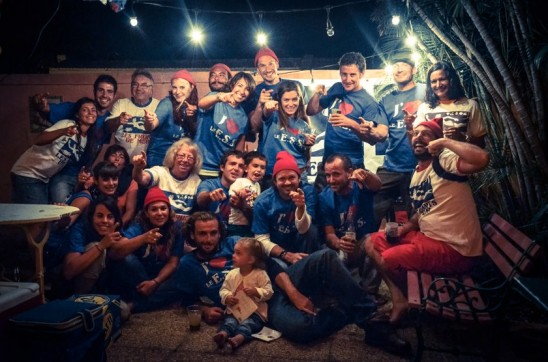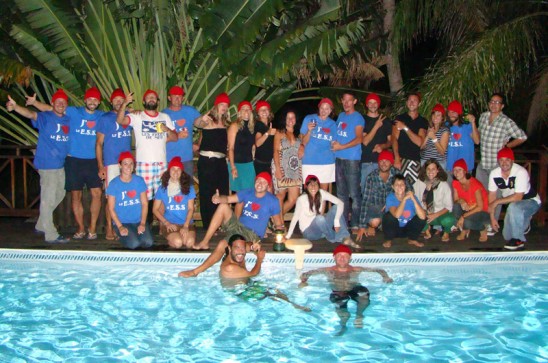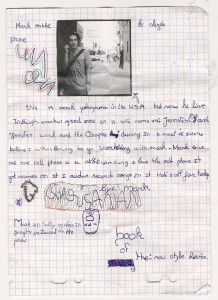March 21st, 2013 by Marc AuMarc
Another year, another Tacousteau. Our 2013 event was, as always, a feast for the body (tacos) and the imagination (screenings of Cousteau documentaries). Many thanks to all the Les Fruits de Mer members old and new who joined us for the event, and special thanks to Steph and Olivia for hosting it this year!

Posted in Fruits Friends, Fruits News, Livin'
Comment on this post.
March 1st, 2012 by Marc AuMarc
We had the fourth annual Tacousteau, celebrating the works of our inspiration, Jacques-Yves Cousteau, and the delicious Mexican food tacos. Our first-ever snorkeling contest was won by Xander Petrelluzzi, who retrieved all seven submerged sea creatures on one breath in just 16.7 seconds!

Posted in Fruits News
Comment on this post.
January 31st, 2012 by Marc AuMarc
Yesterday I spent a few hours in the Philipsburg area searching for the Cuban brown anole (Anolis sagrei), which has been seen there. Although I didn’t find it, I did spend a lot of time photographing lizards. The photos below showcase the variations in color and pattern of one of our two native anoles, Anolis gingivinus. The variability in this species is perhaps less striking than that of our other native species Anolis pogus, but is remarkable in its own right. The different looks these lizards achieve are related to maturity and gender, camouflage, control of their body temperature and communication with other lizards.
While these variations are beneficial to the lizards, they can pose a challenge to those who study them. This was particularly true for the first couple centuries of study when most scientists were almost exclusively using dead specimens for their research. Even as late as the 1960s, much research was missing crucial information about both the appearance and behavior of many species. Even today, I would wager there is much to be learned, especially about species in the Lesser Antilles.
Posted in Fruits News
Comment on this post.
January 28th, 2012 by Marc AuMarc
I’ve seen it referred to as either Ravine St. Louis or Rambaud Gut, but whatever you call it, the ravine running between Pic Paradis and La Savane is a terrific place to explore. If you’re driving past it on the main road, it’s the dip between Pic Paradis and the last hill that you crest before the downhill into Grand Case, and you may have noticed loads of banana trees in that little valley.
The ravine extends in both directions from the road. Downhill it heads to Étang Guichard and Friar’s Bay, while uphill it heads towards the top of Pic Paradis. On my last two visits, I’ve explored the uphill section. From the main road, access to the ravine starts at a well, then continues through a number of small farms. After that, you can continue to follow a small stream to its source, which also features a well. Above that area, there is a dry ravine that is easy to follow until the forest gives way to scrub. At this point, the ravine continues, but the lack of a canopy means lots of undergrowth to tackle.
In the first set of photos from the area you can see a variety of forest dwellers as well as a look at the huge buttress roots of a large tree near the source of the stream.
The second set of photos includes a lot of whistling frogs. The literature asserts that there are two similar species on St. Martin, Eleutherodactylus johnstonei and E. martinicensis. Of course, the descriptions of the two species are almost identical, so it looks like someone will need to get to know these frogs a little better. For the record, at the moment I think these are E. johnstonei.
Posted in Fruits News
Comment on this post.
November 23rd, 2011 by Marc AuMarc
On the top of Mont Fortune, it seemed almost obligatory to take some photos of the view and stitch them into a panorama. I didn’t do a great job, but it does give an idea of the amazing view (click to see a bigger version):

I also did a couple smaller panoramas. Here are the central mountains seen from between Orient Bay and Le Galion:

And Caye Verte:

Of course, the full-size versions are much bigger. If anyone is interested, I used some software called hugin to make the panoramas. It’s free and has lots of options, although I’ve found it a bit finicky so far.
Posted in Fruits News, Les Fruits sur la Terre
Comment on this post.
July 18th, 2011 by Marc AuMarc
Due to a rather unlikely turn of events, a photo of mine is in The Economist this week. They happened to do a very interesting article about the mating habits of a particular spider, and I happened to have some photos of that exact spider mating. Not something I would have predicted, and perhaps the last time I have a photo featured in The Economist, but I thought it was neat.

Posted in Fruits News
Comment on this post.
February 3rd, 2011 by Marc AuMarc
If you write a book on the wildlife of Saint Martin and have it sold at the zoo gift shop, one bonus is that you get to visit the St. Maarten Zoo. When we went to drop off some books the manager, Joe, took us on a deluxe tour. Our favorite part was, of course, feeding the monkeys. It’s not a huge zoo, but they have tons of birds, many monkeys and lots of other animals. Definitely worth a visit.
Posted in Fruits News
Comment on this post.
October 2nd, 2010 by Marc AuMarc
I use iPhoto to store my photos, even though I do my editing in Photoshop from the RAW files. Using iPhoto to begin with is probably my mistake, but today I figured out a couple things that will save me some disk space.
If you use the edit function in iPhoto to zoom in on and compare images, then iPhoto will save “modified” copies in the iPhoto library, even if you didn’t actually make any changes. I figured this out because I never modify photos in iPhoto, but had 15GB of modified images from the past 3 months. You can avoid this by using the full-screen mode to zoom in on images and compare.
If you have loads of these images, you can select all the events in your library and then choose Photos>Revert to Original and all these extra copies will be deleted. (The exception is if you have some movie files, it will keep the JPEGs it made as thumbnails for those.) Unfortunately, if you have RAW photos in your iPhoto library that are mixed in with your JPEGs you won’t get the Revert to Original menu option, you’ll get Reprocess RAW instead. In that case, you’re out of luck unless you remove all the RAW photos from the library.
I actually do move my RAW files every few months when I build a new iPhoto library, so from now on, after I pull those out of my library, I’ll revert to original on my old library to make it a smaller archive.
I guess it might be easier to switch to a more pro-style application for workflow management.
Posted in Fruits News
Comment on this post.
June 16th, 2010 by Marc AuMarc
Before our expedition to find the big bat cave, Madam J and I went with Yann and Marie on a semi-ill-fated expedition to snorkel the mangroves. Poor visibility in the water made the mangroves less than ideal, but we were able to see quite a bit of interesting life in Baie de l’Embouchure. The first exciting discovery was a hermit crab in a conch shell with an orange-tentacled anemone attached to it – a walking menagerie. Next, we saw a small octopus in the sand which gradually went into a small hole. While Jenn was taking some video, he even reached out to grab her camera. Finally, we came upon a group of seemingly abandoned fish pots that were full of lobsters, a large nassau grouper and even a big green moray eel. I did take a few spooky photos in the murky mangrove, but even at the highest tide it wasn’t very clear.
Posted in Extreme Shallow Snorkeling, Fruits News
Comment on this post.
March 5th, 2010 by Marc AuMarc
Yesterday Kevin came by for lunch and gave me this short bio that he had written for me. Later we went out to find frangipani leaves for my caterpillar and we found a monarch chrysalis that Kevin is keeping until it hatches. Click to view full-size.

Posted in Fruits Friends, Fruits News
Comment on this post.











































































































